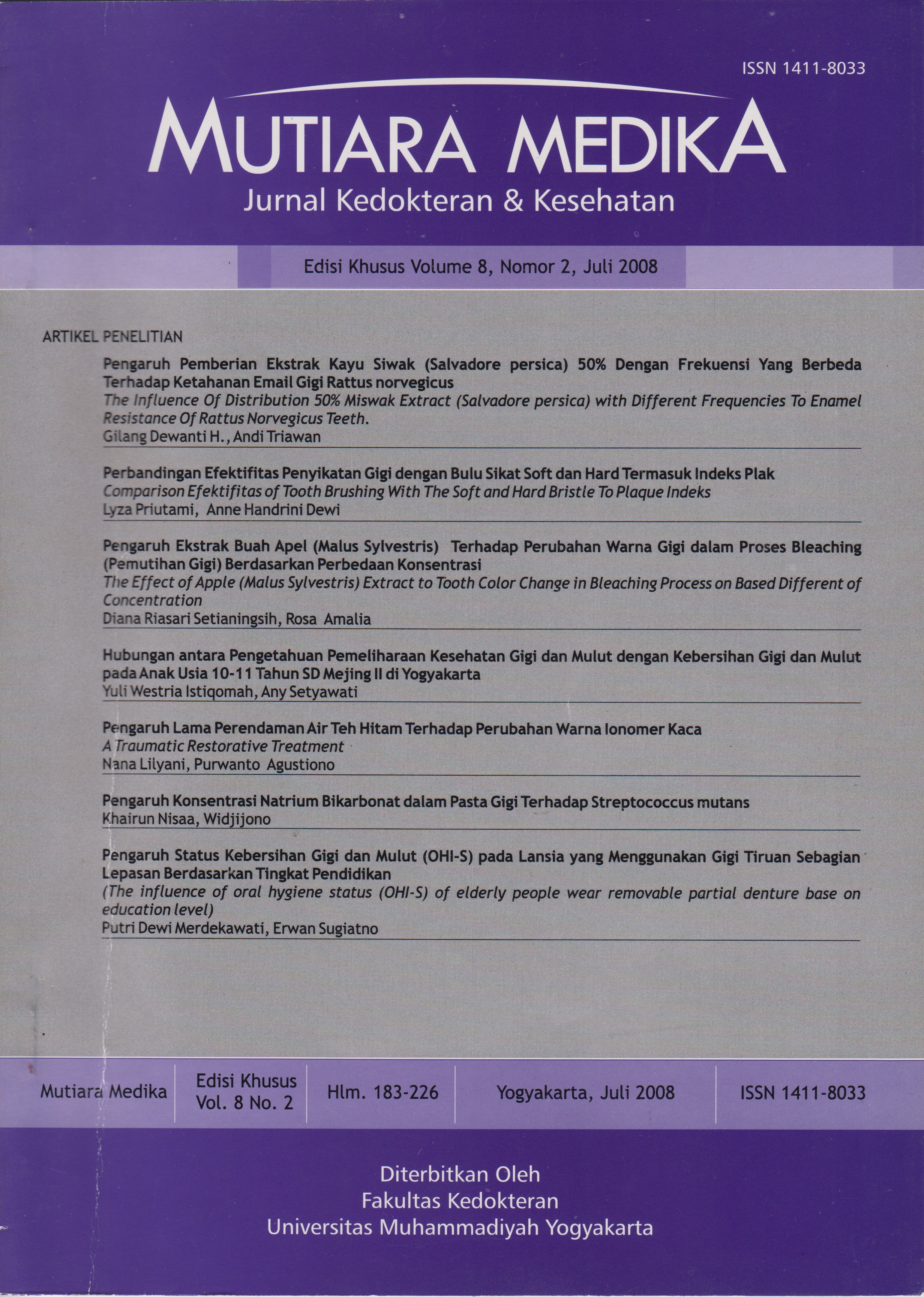Pengaruh Pemberian Ekstrak Kayu Siwak (Salvadore persica) 50% Dengan Frekuensi Yang Berbeda Terhadap Ketahanan Email Gigi Rattus norvegicus
DOI:
https://doi.org/10.18196/mmjkk.v8i2%20(s).9402Keywords:
enamel resistance, frequency, Miswak (Salvadora persica) extractAbstract
Miswak (Salvadora Persica) have antibacterial substances which can reduce the amount of bacteria in mouth so the tooth become healthy and prevent incidence of holey tooth. Intention of this research is to analyze usage of 5 0% miswak extract with different frequencies (1 x one day, 3 days once and once a week) to acid resistance of Rattus norvegicus tooth enamel.
Research subject use I5 Rattus norvegicus at the age of 20 old days. The treatment is given 50% miswak extract topically on the incisivus tooth of Rattus norvegicus lower jaw with different frequencies. Each group (consist of 5 Rattus norvegicus) divided based on the frequencies that giving. The frequencies are I x one day, once every 3 day and once every a week. Treatment conducted during 30 day. After Rattus norvegicus in the age of 51 days, incisivus tooth of Rattus norvegicus taken away from lower jaw. After that phosphoric acid gel 37% applied above entire/all surface of tooth. We roentgen the tooth with digitally periapical Roentgen and calculated the damage on the enamel with score.
Research result indicate that the given of 5 0% miswak extract with frequency I x one day, once every 3 days and once a week have significant difference (p=0,024) to acid resistance of Rattus norvegicus tooth enamel. Giving of 5 0% miswak extract with frequency I x is one day compared to with frequency once every 3 days also have difference which significant (p=0,042). While comparison between the giving of 50% miswak extract with frequency I x one day and once a week also have significant difference (p=0,020).
Conclusions of research, the giving of miswak extract 5 0% with different frequency have different influence significantly to acid resistance of Rattus norvegicus tooth enamel. Miswak is a natural substance that can use for keep our mouth health.
References
Almas, K. (1995). The Effect of Salvadora Persica Extract (MiswakK) and Chlorexidine Gluconate on Human Dentin. Riyadh, Kingdom of Saudi Arabia. Department of Preventive Dental Sciences, King Saud University College of Dentistry.
Lewis, M., (1982). The therapeutical potential of plants used in dental folk medicine.. Odontostomatol Trop
Farooqi M.|.H dan Srivastava J.G. (1968). The Toothbrush Tree (Salvadora persica). Quart. J. Crude Drug Res. Hlm 1297-1299.
KhooryT. (1983). The use of chewing sticks in preventive oral hygiene. Clinical Preventive Dentistry; 5:11-14.
Suwelo, l. 8., (1992). Karies Gigi pada Anak dengan Pelbagai Faktor Etiologi. Jakarta. EGC. Hlm. 1-5.
Tarigan, R. (1990) Karies Gigi. Cetakan (1). Jakarta. Hipokrates.
Kidd, E.A.M., dan Bechal, S.J. (1992). Dasar-dasar Karies Penyakit dan Penanggulangannya. Penerjemah. Sumawinata, N., dan Faruk, S. Jakarta.EGC. Hlm. 100-134
Gazi Ml, Davies TJ, Al-Bagieh N and Cox SW (1992). The immediate and medium- term effects of Meswak on the composition of mixed saliva. J Clin Perio- dontol; 19: 113-117
Fejerskov, 0., Manji, F., Baelum, V., Moller, I. J., (1991) Fluorosis ll. Jakarta. Hipokrates. Hlm. 7-9.
El-Mostehy, DR. M., Ragaii,A.A., AI- Jassem, l.A., Al-Yassin, A.R., El- Gindy, E., Shoukry. (1991). Siwak As an Oral Health Device (Preliminary Chemical And Clinical Evaluation). Kuwait. Department of Odontology, Faculty of Dentistry, University of Kuwait
Downloads
Published
Issue
Section
License
Copyright
Authors retain copyright and grant Mutiara Medika: Jurnal Kedokteran dan Kesehatan (MMJKK) the right of first publication with the work simultaneously licensed under an Attribution 4.0 International (CC BY 4.0) that allows others to remix, adapt and build upon the work with an acknowledgment of the work's authorship and of the initial publication in Mutiara Medika: Jurnal Kedokteran dan Kesehatan (MMJKK).
Authors are permitted to copy and redistribute the journal's published version of the work (e.g., post it to an institutional repository or publish it in a book), with an acknowledgment of its initial publication in Mutiara Medika: Jurnal Kedokteran dan Kesehatan (MMJKK).
License
Articles published in the Mutiara Medika: Jurnal Kedokteran dan Kesehatan (MMJKK) are licensed under an Attribution 4.0 International (CC BY 4.0) license. You are free to:
- Share — copy and redistribute the material in any medium or format.
- Adapt — remix, transform, and build upon the material for any purpose, even commercially.
This license is acceptable for Free Cultural Works. The licensor cannot revoke these freedoms as long as you follow the license terms. Under the following terms:
Attribution — You must give appropriate credit, provide a link to the license, and indicate if changes were made. You may do so in any reasonable manner, but not in any way that suggests the licensor endorses you or your use.
- No additional restrictions — You may not apply legal terms or technological measures that legally restrict others from doing anything the license permits.






